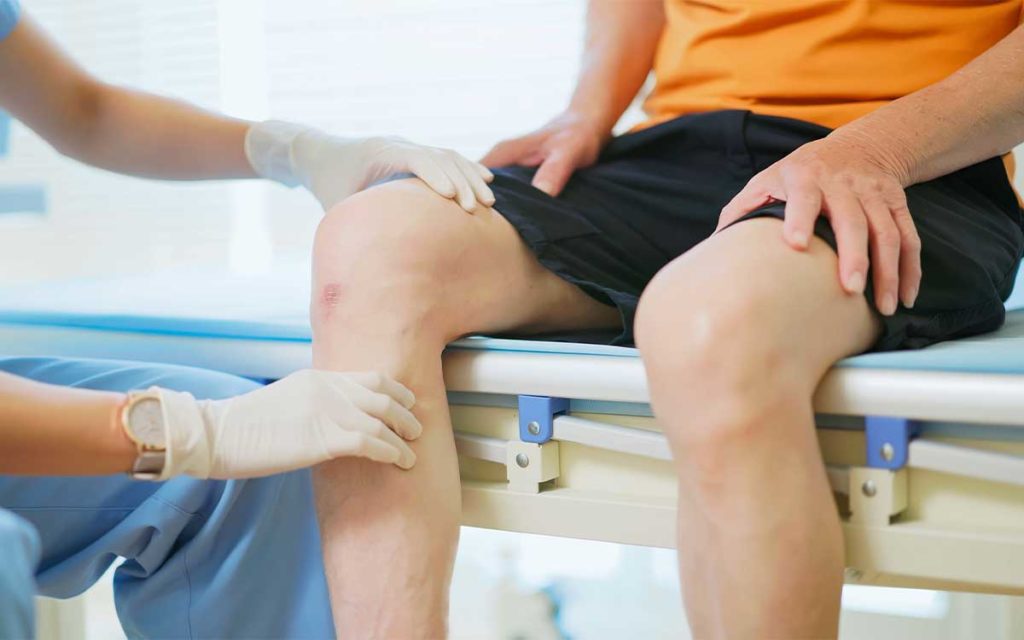Surgery for knee replacement can be one of the most life-changing options for patients seeking bone-on-bone knee pain relief and limited mobility, reducing their quality of life. Bone-on-bone knee pain is common, but many treatments are available. And, not all of those options involve having one of the many different types of knee replacements.
Read on to learn about the diagnosis, non-invasive treatments, and surgical options available for relieving pain caused by bone-on-bone arthritis.
What Does Bone-on-Bone Knee Pain Feel Like?
Bone-on-bone knee pain, caused by advanced arthritis, can vary from person to person depending on its severity. Generally speaking, it will feel like a dull and achy pain. However, some people get a sharp pain that can bounce back and forth between those two qualities.
For most patients, their pain’s location correlates with where there is bone-on-bone contact. This condition can happen when you wear away the cartilage in a joint, and bones start grinding against each other.
Worth noting is the fact that arthritic pain is typically localized. It doesn’t typically radiate. Knee pain hurts in the knee versus other joint pains, which can travel to various body parts. An example of radiating pain might be lower back pain that radiates to the lower leg or foot.
How Is Bone-on-Bone Knee Arthritis Diagnosed?
A bone-on-bone arthritis diagnosis always starts with collecting a patient’s medical history. An orthopedist will conduct a thorough physical examination.
Assuming a patient has knee pain and the objective findings on the exam are consistent with the subjective complaints, it’s formally diagnosed with an x-ray that confirms the appearance of arthritis or bone-on-bone joint disease.
Learn the Common Reasons Why Some Patients Need Knee Replacements →
What Can You Do to Get Bone-on-Bone Knee Pain Relief?
There is a spectrum of treatment options available—from conservative and non-operative treatments to surgery—to achieve bone-on-bone knee pain relief.
Non-Invasive Treatments
Ice and over-the-counter pain medication like acetaminophen or ibuprofen can help. Sometimes physical therapy or a guided exercise program can provide bone-on-bone knee pain relief by strengthening the muscles that support the knee, particularly the quadriceps.
The next step up from over-the-counter medication is intra-articular injections or shots into the knee joint. Cortisone injections are the most common type. Viscosupplementation, or gel injection, is another.
Read Our Ultimate Guide to Finding Knee Pain Relief
Knee Replacement Surgeries for Bone-on-Bone Arthritis

Your orthopedist may recommend a total or partial knee replacement for bone-on-bone knee pain relief, also called arthroplasty, if they diagnose your condition as being more advanced arthritis. “Arthro” means joint, and “plasty” means to make or create. When talking about joint replacement, arthroplasty and joint replacement are synonymous terms.
A total knee replacement is the most common knee replacement surgeries for bone-on-bone arthritis. This surgery involves resurfacing the ends of your knee joint bones, including the femur (or thigh bone) and tibia bone. This process is similar to capping a tooth.
Typically, metal components are cemented to the ends of the bone. A plastic or polyethylene insert or dish is placed between the two pieces of metal. After bone-on-bone knee replacement surgery, your joint is now metal gliding on plastic instead of grinding bone-on-bone. The result is no pain because there are no nerves in metal or plastic.
Find Out What to Expect After Knee Replacement Surgery →
Surgery for bone-on-bone knee pain relief can take anywhere from 45 minutes to an hour and a half, depending on the unique presentations of a case.
A partial knee replacement resurfaces only one of the three knee compartments where arthritis is present. Your orthopedic surgeon will leave the healthy compartments of the knee intact. This differs from total knee replacement, where all three compartments of the knee are addressed at once.
Learn About New Technologies and the History of Total Knee Replacement Surgery →
FAQs About Bone-on-Bone Knee Replacement Surgery
What Is the Newest Surgical Treatment for Bone-on-Bone Knee Arthritis?
Bone-on-bone knee replacement continues to evolve as medical professionals learn more about available advanced technologies. With the hope of improved longevity, the medical community tests new materials for improved durability and strength.
Our modern-day components include cobalt-chromium, a type of metal, ceramics (used only in rare cases when there is a metal allergy), and the latest generation polyethylene, a plastic with much better wear and mechanical properties than older plastics.
Is Walking Good for Bone-on-Bone Knee Pain Relief?
Walking has positives and negatives. In general, it’s always good to maintain some degree of weight-bearing activity because it benefits your overall cardiovascular health, bones, and muscles. However, occasionally walking can cause a flare-up of pain in the arthritic knee.
Patients with bone-on-bone knees aren’t restricted from any specific activity, but they should listen to their bodies and select less impactful activities on the knee joints.
Which Exercises Can Make Your Pain Worse if You Have Bone-on-Bone Arthritis?
Many exercises can be painful and impact knee joints in patients with bone-on-bone arthritis. Running is one of the most impactful exercises but can vary based on surface, duration, weight, and other factors.
Patients who like to maintain an active lifestyle can reduce their impact by stepping down their specific exercises. The following exercises are listed in order from most to least impactful on the knee joint:
- Running on Concrete
- Running on a Track
- Running on a Treadmill
- Using an Elliptical Machine
- Using a Stationary Bike
- Swimming
What Might Happen If You Wait Too Long to See a Specialist for Bone-on-Bone Knee Pain Relief?
It is rare for a patient to get to the point of bone-on-bone contact that is starting to crush away the tibial plateau or the femoral condyle. Generally, it’s rarely going to reach a point where it’s too late to reconstruct a knee.
However, waiting many years to get bone-on-bone knee pain relief can increase medical comorbidities, such as age or obesity. Additionally, you could be at risk for surgery based on cardiac issues you may have developed later in life.
What Are Signs You Might Need Knee Replacement Surgery for Bone-on-Bone Knee Pain Relief?
An indication that you may need knee replacement surgery to get bone-on-bone knee pain relief is that you’re still experiencing pain, stiffness, or deformity after getting conservative or nonoperative treatments (including injections) for your condition.
Learn More About IBJI’s Knee Replacement Surgeons
If your knee pain affects your quality of life, look to IBJI’s highly trained surgeons and doctors who can help you get bone-on-bone knee pain relief.
Today, more than 90% of patients who have had surgery report that their replacements are still going strong 15 years later, according to research from the American Academy of Orthopedic Surgeons.
IBJI offers convenient locations across the Chicagoland area, and we are experts in arthritis treatment, pain management, and modern total knee joint replacement surgical techniques and technologies.
Get Bone-on-Bone Knee Pain Relief
Find a knee doctor near you, and—when you’re ready—schedule online today.




